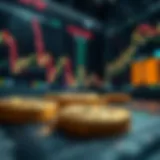Creating NFT Characters: Your Ultimate Guide
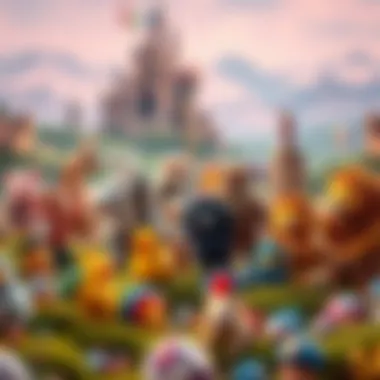
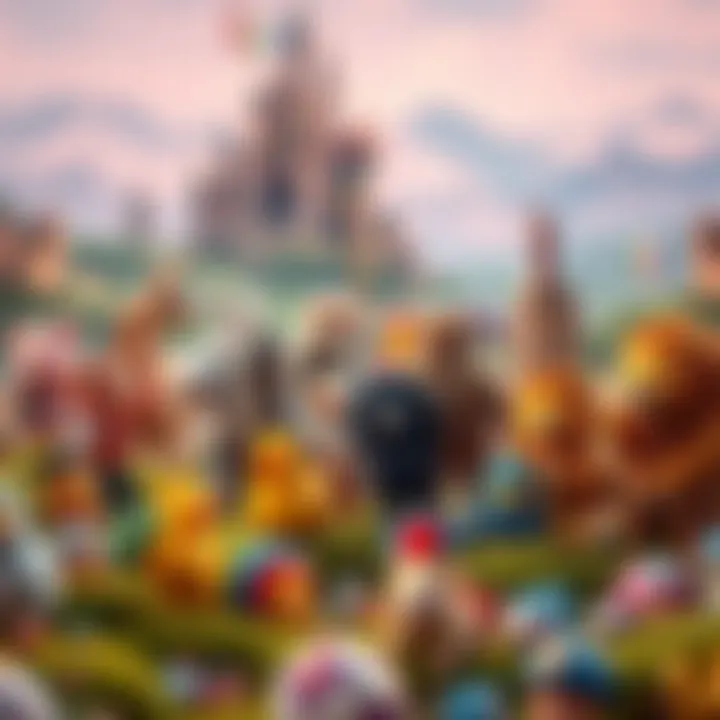
Intro
In a rapidly evolving digital landscape, the emergence of Non-Fungible Tokens (NFTs) has reshaped how we perceive ownership and value in the digital realm. While NFTs find their application across various sectors like art, music, and gaming, the creation of NFT characters stands out as a compelling intersection of creativity and technology. This guide is designed to navigate the intricate process of developing engaging and marketable NFT characters, offering insights and strategies that cater to both novices and experienced artists.
As we move further into this exploration, it’s crucial to grasp the foundational concepts of cryptocurrency that underpin NFT creation, as they serve as the bedrock for understanding the character development process.
Key Concepts in Cryptocurrency
Understanding the world of cryptocurrency is not just an intellectual exercise; it’s essential for anyone looking to thrive in the NFT space. The foundation is built on several pivotal concepts that drive the functionality and appeal of NFTs.
Understanding Blockchain Technology
At the heart of NFTs lies blockchain technology, which can be described as a digital ledger that records transactions across many computers to ensure that records are secure, transparent, and immutable. Each NFT is a unique token on a blockchain, representing ownership of a specific digital asset.
- Decentralization: Unlike traditional assets, ownership is not controlled by a central authority but by the network participants.
- Transparency and Security: Each transaction is publicly recorded, reducing the chances of fraud.
- Interoperability: NFTs can exist across multiple platforms, allowing for broader applications.
Without a solid understanding of how blockchain works, creators might stumble in their efforts to craft compelling NFT characters, as the token's value is intrinsically linked to its underlying technology.
The Role of Smart Contracts
Smart contracts are critical to the NFT ecosystem. They are self-executing contracts with the terms of the agreement between buyer and seller directly written into code. This automation not only streamlines the transaction process but also ensures creators retain rights and royalties.
Key advantages include:
- Automated Execution: Reduces the need for intermediaries, speeding up transactions.
- Royalty Features: Many platforms allow artists to program royalties into their NFTs, ensuring they receive a percentage of sales whenever their character is resold.
Given these capabilities, understanding how to design and implement smart contracts can empower creators to maximize their potential earnings and maintain control over their creations.
"A character without a story is merely a shell. Likewise, an NFT without a solid foundation in blockchain and smart contract knowledge lacks substance."
Market Trends and Analysis
As we delve deeper into the market dynamics surrounding NFTs, it's essential to keep an eye on the trends that shape this ever-evolving space. The NFT marketplace is a bustling ecosystem, influenced by many factors.
Current Market Dynamics
The NFT market has seen explosive growth, driven by the intersection of art and technology. High-profile sales like Beeple's digital collage or the rise of play-to-earn games have thrust NFTs into the spotlight, attracting investors and artists alike. Observing current trends involves:
- Increased Gamification: As gaming and NFTs converge, characters become digital assets.
- Brand Collaborations: Major brands, including Nike and Coca-Cola, are dabbling in NFTs, establishing character-driven identities in virtual landscapes.
Predictions for Emerging Cryptocurrencies
With cryptocurrency markets constantly fluctuating, setting clear expectations can be tricky. However, market analyses suggest that certain niches, including NFT creation tools and platforms, could see substantial growth in the coming years.
- Emerging Platforms: New blockchain platforms focusing on sustainability and speed are likely to attract characters and creations that emphasize eco-friendly practices.
- Innovative Monetization Models: As the market matures, new revenue streams will emerge, such as fractional ownership of high-value NFTs, making character investments accessible to a wider audience.
Grasping these dynamics is not merely academic; it equips creators with the insights necessary to navigate the complex landscape, enhancing their ability to succeed.
This guide will further delve into practical elements of character design, tools, and successful marketing strategies to arm you with the tools necessary for your NFT creation journey.
Understanding NFTs and Their Impact
In today's digital landscape, NFTs are reshaping how art, collectibles, and even virtual real estate are perceived and traded. Understanding NFTs serves as the foundation for anyone looking to create unique characters in this evolving ecosystem. By knowing what NFTs are and the significant role they play, creators can better position their distinctive digital assets.
Definition of Non-Fungible Tokens
Non-fungible tokens (NFTs) are unique digital tokens that represent ownership of a specific item or piece of content on a blockchain. Unlike cryptocurrencies such as Bitcoin or Ethereum, which can be exchanged for one another (thus termed fungible), NFTs are one-of-a-kind and cannot be directly replaced. Each NFT carries distinct information that makes it irreplaceable and verifiable.
By utilizing smart contracts, these tokens can be linked to anything from art, music, and video to virtual real estate. In essence, the uniqueness is what gives NFTs their value. A famous piece, like a digital artwork by Beeple, becomes not just an image but a certified distinct piece in the digital realm.
Historical Context of NFTs
The origins of NFTs trace back to the early 2010s when colored coins emerged on the Bitcoin blockchain. However, it wasn't until the launch of Ethereum in 2015 that the NFT landscape began to flourish. Ethereum introduced the ERC-721 standard, which made it easier to create unique digital assets. By 2017, projects such as CryptoPunks and CryptoKitties unveiled the real potential of NFTs, capturing the attention of tech enthusiasts and investors alike.
Culturally and economically, NFTs skyrocketed in 2021. The sale of a digital collage by Beeple for over $69 million at Christie’s not only sparked global headlines but also highlighted the mainstream interest in digital art.
The Role of NFTs in Digital Art
NFTs have revolutionized the landscape of digital art. For years, digital artists faced challenges in proving ownership and ensuring their works had value. With the advent of NFTs, artists can now tokenize their creations, providing a mechanism for buyers to prove authenticity and ownership. This change has empowered a wave of creators who might have felt sidelined in traditional art markets.
Furthermore, NFTs enable artists to earn ongoing royalties through resale, a feature typically absent in traditional art sales. As the market expands, NFTs provide artists with broader exposure while creating avenues for sustainable income.
As the journey of NFT characters begins, understanding these elements is crucial. Embracing the novelty and potential of NFTs can ultimately shape how creators approach their work, influencing both their design and marketing strategies.

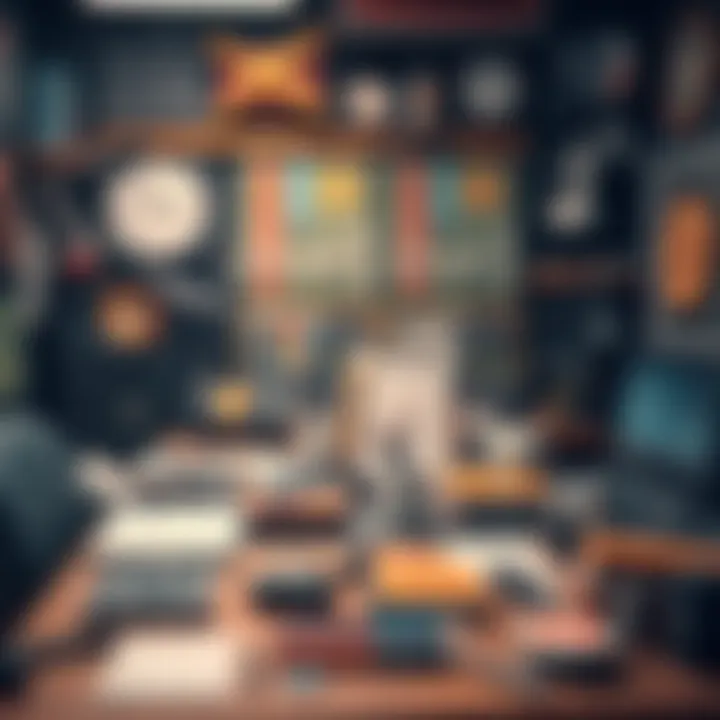
Conceptualizing Your NFT Character
Creating a distinctive NFT character requires more than just artistic flair; it necessitates understanding and thoughtful design. This section delves into the crucial components of conceptualizing your NFT character, focusing on how you can craft something meaningful and appealing to audiences. The importance of this phase cannot be understated, as character creation lays the groundwork for all future steps, from visual representation to marketability. When you take the time to conceptualize deeply, it paves the way for a character that resonates with your target audience and stands out in the crowded NFT landscape.
Identifying Your Target Audience
Knowing your target audience is like having a treasure map; it helps guide your creative decisions effectively. When creating your NFT character, take a moment to step into the shoes of those who might buy or admire your work. Who are they? Are they collectors with a passion for digital art? Perhaps they are gamers seeking unique avatars?
Focusing on specific demographics can shape the direction of your design and story. For example, if your audience skews towards younger users who play video games, your character might need vibrant colors and a playful personality. In contrast, a more mature audience might appreciate a character that’s sophisticated and nuanced.
By understanding your audience's preferences, you can tailor every aspect of your NFT character, making it relevant and attractive. This specificity not only enhances appeal but also increases its potential value in the marketplace. Developer communities, social media channels, and online forums can serve as valuable resources for gathering insights into your audience’s tastes and preferences.
Character Design and Storytelling
Creating a Backstory
Every compelling character has a backstory, much like people in real life. A rich backstory gives depth and context to your NFT character, enabling potential buyers to form an emotional connection. Think of the intricate histories behind beloved characters in comics or movies; it’s not just about the surface level traits but the narrative that brings them to life.
Crafting a backstory might involve defining where your character comes from, the challenges they've faced, and their ultimate dreams or goals. A riveting backstory enhances relatability, making the character more than just a digital figure—it becomes a symbol of aspirations or struggles that collectors can resonate with.
The key characteristic of a well-thought-out backstory lies in its ability to engage, as it can trigger curiosity and interest. However, the challenge here is to avoid over-complication. Keeping the backstory concise while still captivating is essential.
Defining Personality Traits
Personality traits play a significant role in breathing life into your NFT character. Think about characters you admire. What makes them memorable? Often, it's their distinct personality that sets them apart.
Defining these traits involves considering how your character behaves in various situations. Is your character brave, quirky, or perhaps a bit mischievous? The choices you make here not only affect visual design but also influence the narrative aspects of your creation. Potential buyers may look for traits that they can attach themselves to, just as fans often gravitate toward fictional personas that reflect their own ideals.
A unique feature of personality traits is their ability to reflect diverse aspects of humanity. This can create a strong connection with audiences, encouraging them to appreciate or even invest in your NFT character. However, a downside might be if your character ends up being too generic, lacking depth or specificity, which could diminish market appeal.
Visual Style and Aesthetics
Color Theory
The aesthetic aspect of your NFT character is often the first thing that attracts attention. Here, color theory plays a vital role. Colors evoke emotions and set the tone for your character. For instance, warmer colors like red and orange may convey energy and passion, while cooler colors like blue and green can suggest calmness and serenity.
Familiarizing yourself with the principles of color theory can dramatically influence the effectiveness of your character's design. Using contrasting colors can create visual pop, while analogous colors might convey harmony. The benefit of a well-executed color palette is that it leads to better retention of your character in potential buyers' minds. However, it’s essential to avoid going overboard; a character with too many conflicting colors might confuse or detract from its appeal.
Character Proportions
The proportions of your character are just as crucial as color. Proper proportions lend credibility and relatability to your designs. Understanding basic anatomical principles can provide a foundation for creating characters that feel believable, regardless of their fantastical elements. Consider cartoonish styles that exaggerate proportions for comedic effect, or more realistic styles emphasizing human traits.
Using proportions effectively can enhance storytelling. For example, larger heads may suggest youthfulness, while more elongated limbs can evoke elegance or speed. The unique advantage of getting proportions right is the ability to convey complexity or simplicity as desired. However, overcomplicating the design can lead to a character that feels disjointed or hard to recognize.
"In the world of digital art, character design is a dance between imagination and relatability, where the steps taken can lead to either masterpiece or misstep."
Conceptualizing your NFT character is a blend of artistry and strategy, drawing on a comprehensive understanding of design principles to create something that resonates with audiences. By carefully identifying your target audience, weaving captivating stories, and integrating visual elements wisely, you set the stage for a character that not only attracts attention but holds lasting significance in the burgeoning realm of NFTs.
Selecting the Right Tools for Creation
When diving into the world of NFT character creation, selecting the right tools is akin to a painter choosing their brushes and colors. It’s not just about having tools; it’s about having the right tools that align with your vision and expertise. The software and resources you select play a vital role in shaping your creative output and enhancing the overall workflow. A well-thought-out toolkit supports your artistic intentions and makes the daunting tasks simpler and more intuitive.
Software Options for Digital Art
Adobe Illustrator
Adobe Illustrator stands tall when it comes to vector graphics design. What sets Illustrator apart is its scalability; you can enlarge or shrink artwork without compromising quality, which is incredibly beneficial for creating NFT characters. As a popular choice among artists, Illustrator offers a vast array of features that cater to both beginners and seasoned creators.
One of its unique features is the ability to use Artboards, which enables artists to create multiple designs in a single document without hassle. This is useful when experimenting with different character designs or variations. However, it’s worth noting that Illustrator has a steep learning curve for newcomers, which can initially be puzzling.
Procreate
For those who prefer sketching with a bit more sensitivity, Procreate shines brilliantly in the digital art domain, specifically on the iPad. Its intuitive interface lets you wield natural brush strokes directly with your fingers or an Apple Pencil, enabling a more organic creation process. Procreate is celebrated for its extensive library of brushes and the ability to create custom brushes, which allows for unique styles that resonate with artists wanting to showcase individual flair in their characters.
One standout feature is the Animation Assist, which facilitates creating quick frame-by-frame animations. The downside? Procreate is only available on iOS devices, limiting accessibility for those who use other systems.
Blender
When it comes to creating 3D characters, Blender cannot be overlooked. Known for its robust feature set, Blender is often lauded as one of the leading open-source tools available. It provides a comprehensive suite for modeling, sculpting, and animating, making it ideal for those wishing to explore the 3D space. A core advantage of Blender is its community support; with numerous tutorials and resources available online, users can easily find guidance and inspiration.
What makes Blender particularly beneficial is its ability to render high-quality animations and visuals. However, the complexity may overwhelm novice users, as it has a rich feature set that requires time to fully master.
Incorporating 3D Elements
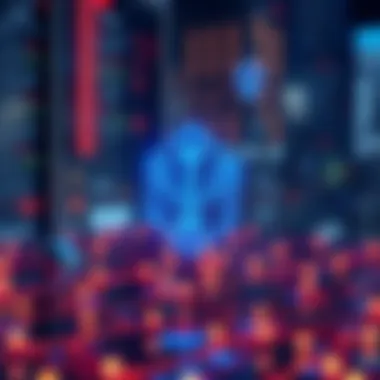

Integrating 3D elements into NFT characters can elevate the visual experience dramatically. Unlike flat designs, 3D models offer depth and realism, allowing viewers to interact in a more engaging way. Moreover, using 3D elements gives creators the flexibility to manipulate characters in diverse environments, enhancing storytelling through visuals.
To get started with 3D integration, creators should familiarize themselves with tools designed for this purpose, like Blender or Maya, and consider how their character will move and exist in virtual spaces. This additional layer of complexity can ultimately differentiate a mediocre NFT from an extraordinary one.
Animation Possibilities
Understanding Animation Techniques
Animation breathes life into static characters, making them dynamic and engaging. Understanding basic animation techniques, such as keyframing and easing, lays the foundation for developing smooth movement. This knowledge is crucial for NFT characters, as animated pieces often stand out in marketplaces, capturing the attention of potential buyers.
A notable characteristic of animation is that it requires a keen eye for motion; not all animations need to be elaborate or lengthy to be effective. Simple movements can communicate personality and intention, grounding characters in their uniqueness.
Integrating Digital Animation
Integrating digital animation into your creations isn't just about moving images; it's about crafting experiences. Effective integration can add layers of interaction and engagement that static images simply can't offer. Tools such as Adobe After Effects or even Blender can help give those character designs the punch they need to captivate an audience.
One distinct advantage of using digital animation is that it allows for quick modifications and iterations. If a character's movement doesn't sit right with the overall narrative, it's far easier to tweak an animated feature than to redesign a static character altogether. Yet, keep in mind that animations can become resource-intensive, so always consider file size and performance, especially for Web3 integration.
By carefully choosing the right tools and understanding the ins and outs of animation, creators can elevate their NFTs from simple images to captivating digital art pieces that resonate with audiences.
Minting Your NFT Character
Minting an NFT character is a crucial step in transforming your digital artwork into a tangible asset on the blockchain. It’s not just about uploading your creation; it’s the process that locks in ownership, provenance, and the potential for passive income through royalties. Securing your character as an NFT gives it an identity within digital marketplaces, opening the door to collectors and audiences worldwide. This section delves into vital aspects of minting, helping you navigate the pathway with clarity.
Choosing the Right Blockchain
Selecting the right blockchain for your NFT character is pivotal. Different options come with their own strengths and weaknesses, influencing not just the creation process, but also the value and functionality of your NFT.
Ethereum vs. Alternative Blockchains
Ethereum stands high on the pedestal when it comes to NFTs, renowned for its robust smart contracts and a thriving ecosystem of digital art. Unlike many alternative blockchains, Ethereum has a well-established user base. The security offered by its Proof of Work mechanism means that buyers often feel safer purchasing Ethereum-based NFTs. However, Ethereum is not without flaws; its high transaction fees can be a hurdle, especially for new artists.
On the other hand, alternative blockchains such as Tezos and Flow provide faster transactions and lesser gas fees. This can be an attractive feature for creators anxious about overhead costs. The unique aspect of Tezos, for example, lies in its energy-efficient mechanism, appealing to environmentally conscious artists and buyers alike. These alternatives can attract different audiences, expanding the potential market for your NFT characters. Choosing a blockchain ultimately relies on evaluating your priorities: security versus cost efficiency.
Gas Fees Considerations
Gas fees play a significant role in the minting process. This is the cost you incur to execute transactions on a blockchain, most notably with Ethereum. The fees can fluctuate wildly depending on network congestion. High gas fees can discourage potential buyers and limit your audience. It’s wise to keep an eye on market trends and timing your minting can save a pretty penny.
In contrast, blockchains like Polygon offer considerably lower fees, making them an appealing choice for those looking to minimize expenses. However, this can lead to trade-offs in terms of market visibility, as fewer buyers flock to these less-popular platforms. Navigating these fees is essential to ensure that your works don’t go underpriced or forgotten in a crowded digital landscape.
NFT Standards: ERC-721 vs. ERC-1155
NFT standards dictate how the ownership and transfer of tokens are managed on the blockchain. ERC-721 is the original standard, tailored for unique, single-instance tokens. This is where individual character traits shine, making each creation stand alone. On the flip side, ERC-1155 is a multi-token standard that allows for batch minting. This means you can create multiple variations of a character—like different skins or traits—with one single contract. Understanding these distinctions can significantly enhance how creators engage with their audience, catering to various collectors’ preferences.
Process of Minting: Step by Step
Each step in the minting process is fundamental for the successful deployment of your NFT character. Here’s a breakdown of the different aspects involved, ensuring that every detail is catered to.
Creating a Wallet
Before diving into the creation of your NFT, having a reliable wallet is a non-negotiable prerequisite. A digital wallet serves as the storage area for your cryptocurrencies and NFTs. Most users gravitate towards wallets like MetaMask or Coinbase Wallet for their user-friendliness. The primary advantage of opening a wallet is the control it provides—no third-party involvement means you keep all your assets secure. However, remember that the responsibility lies heavily on your shoulders. Losing access can mean losing your work.
Uploading Your Artwork
Once the wallet is set up, the next step is to upload your artwork to the chosen platform. The ease of this process often depends on your blockchain choice. Many platforms provide straightforward interfaces for this. Some, like OpenSea, even allow you to add attributes directly, enhancing your character’s profile. Each upload can carry metadata, including descriptions and hashtags. A well-optimized upload helps not only in identification but also increases discoverability in the vast ocean of NFTs. But keep in mind that once your artwork is uploaded and minted, alterations become a headache; early planning pays off.
Setting Royalties
Setting up royalties is a strategic move that can yield income long after the initial sale. This feature allows you to earn a percentage from every resale of your character. Most platforms offer flexible options, allowing you to set royalty rates—up to 10% typically. This means if your character gains popularity and is sold multiple times, you can continue to benefit from its success. However, a too-high royalty might deter buyers initially. It is essential to find an equilibrium that maximizes your earnings while keeping your characters accessible to collectors.
Minting your NFT is like planting a seed. The right environment and care can lead to a flourishing digital asset that interacts with diverse communities.
Marketing Your NFT Characters
Marketing your NFT characters is crucial in today’s saturated digital landscape. As new creators flood the market, standing out amidst the crowd becomes increasingly difficult. In this context, effective marketing strategies become not just beneficial but essential for success.
The digital art world, especially NFTs, often feels like a race against time to capture interest before the next big creation drops. Creators must not only develop characters but also craft compelling narratives around them, driving collectors to want to own a piece of their creativity.
Identifying Effective Channels
Social Media Engagement
Social media has shifted the game in how artists connect with audiences. Platforms like Instagram and Twitter pull the curtain back on the creative process, letting followers peek behind the scenes. This transparency builds trust and develops a loyal following among potential buyers.


One key characteristic of social media engagement is the ability to reach a broad audience quickly. With just a few posts, a creator can share their latest NFT character, potentially reaching thousands. The rapid spread of content, driven by shares and retweets, can create viral interest, which is a huge advantage in terms of visibility.
However, it’s not all roses. The fast pace of social media also means that attention spans are shorter. A creator’s post might be buried under a flood of new content within minutes. Additionally, algorithms on these platforms can be fickle; it’s tough to continually ensure maximum reach without investing time and sometimes money in sponsored content.
Collaborations with Other Artists
Collaborating with other artists can amplify your visibility, creating new opportunities that might not have been accessible solo. By joining forces, artists can pool their fan bases, introduce audiences to each other's work, and explore fresh creative ideas. This collaboration often leads to innovative crossover projects that attract attention from both fan bases.
The collaborative spirit in the NFT space is evident, and successful partnerships can result in unique character designs or joint exhibitions. However, this tactic does come with its own risks; creative differences between collaborators can lead to misunderstandings or dilute individual styles. Still, if done right, collaboration can propel both artists into the spotlight.
Building a Community Around Your Work
Utilizing Discord and Forums
Moving beyond traditional social media, platforms like Discord and niche forums offer unique spaces where creators can interact directly with their audience. These platforms allow for deeper engagement through conversations about characters, ideas, and fan feedback.
One significant benefit of these spaces is that they foster a sense of belonging among fans. Being part of a community can encourage individuals to become more invested in the success of the creator and their characters. However, managing these communities demands time and consistent interaction from creators, which can be a challenge.
Organizing Virtual Events
Virtual events, such as online galleries or live-streamed Q&A sessions, bring communities together while showcasing NFT characters engagingly. These events create buzz and generate excitement, often leading to increased interest and sales. Not only do they function as a platform to showcase work, but they also help in solidifying relationships with the audience.
The unique feature here lies in the level of interaction possible; fans can ask questions and give direct feedback during such events. However, organizing these events requires significant planning and promotion to ensure a good turnout, which can be a considerable investment of time and resources.
In summary, marketing NFT characters is all about creating genuine connections, leveraging platforms that resonate with the audience, and building a community eager to engage and support the creator's journey.
Successfully navigating these marketing avenues positions creators to not just showcase their NFT characters but to foster lasting relationships with buyers and fans alike.
Understanding Intellectual Property in NFTs
The digital landscape is transforming right before our eyes, and the advent of Non-Fungible Tokens (NFTs) has sparked exciting possibilities, yet also raised critical questions about ownership. Understanding intellectual property in the context of NFTs is paramount for anyone dealing with digital art and characters.
Navigating the world of NFTs without grasping the implications of intellectual property can lead to missteps that could be costly. For creators, understanding property rights is key to protecting their work. For buyers, comprehending these rights means knowing what they are purchasing, allowing them to appreciate the value of their investment fully.
Copyright Considerations
Copyright may sound archaic, but in the NFT realm, it’s more relevant than ever. As a creator, when you mint an NFT, you are essentially infusing your original work with digital permanence. It’s crucial to understand that minting doesn’t automatically transfer copyright unless explicitly stated.
When an artist creates a character and mints it as an NFT, they retain the copyright, allowing them to control how their work is used. This protection means that others can’t just take the character and run with it unless they have permission or the proper licenses.
Consider the following points about copyright:
- Originality: Your character must be original. If it’s heavily inspired by existing works, you might be wading into murky waters regarding copyright infringement.
- Licenses: Think about including specific licenses that outline how buyers can use the character. This can range from personal use only, to more commercial options.
- Enforcement: Be ready to defend your copyright if necessary. This could involve legal avenues if someone improperly uses your character.
"Intellectual property rights serve as the lifeblood of creativity, guiding, protecting, and nurturing innovative minds as they forge the future."
Understanding the intricacies of copyright ensures that creators can operate without fear of infringement, and buyers can engage in the market knowing the legal landscape.
Rights for Buyers and Sellers
The buying and selling of NFT characters aren’t just transactions; they represent transfers of rights, which can be quite complex. Here’s a simplified breakdown of what rights typically accompany NFT purchases:
For Buyers:
- Ownership of the NFT: Upon purchase, the buyer owns that specific token on the blockchain, which signifies their ownership of that unique digital asset.
- Usage Rights: Often, this does not extend to commercial rights unless specified in a contract. Buyers may need to clarify what they can do with the NFT in terms of reproduction or creation of derivative works.
- Resale Rights: Buyers can resell their NFTs, which might be subject to royalties paid back to the original creator, depending on the arrangement made at the time of minting.
For Sellers:
- Retaining Copyright: Despite selling the NFT, creators typically retain copyright unless they have entered a specific agreement stating otherwise. This means they can continue to create variations or derivatives of the character.
- Setting Terms: Sellers can outline what rights they are transferring. For instance, they can specify user permissions in a contract, steering clear of future misunderstandings.
The delicate dance of rights in NFTs requires careful planning and communication. Knowing the rights attached to an NFT character prevents disputes and fosters trust between creators and buyers.
Understanding these facets of intellectual property not only protects creators but also elevates the collective recognition of NFT art. A well-informed market tends to thrive, attracting even more artists and investors to the world of NFTs.
Evaluating the Future of NFT Characters
As the digital world evolves, the significance of assessing the future of NFT characters cannot be overstated. These creations are not simply images locked in a blockchain; they embody innovative potential, cultural impacts, and economic possibilities. Understanding what's next for NFT characters helps artists, investors, and developers position themselves strategically in an ever-changing landscape. In this section, we will explore the emerging trends in character design and the implications of technology on the creation process.
Trends in Character Design
The trends in character design within the NFT space are as diverse as they are dynamic. Artists are experimenting with forms, styles, and narratives that challenge the conventions of traditional digital art. Some notable trends include:
- Personalization: Collectors are increasingly looking for unique experiences tied to their NFT characters. This shift is pushing creators to design characters that resonate with individual stories, offering a deeper emotional connection.
- Environmental Sustainability: With rising awareness of climate issues, many creators are focusing on sustainable designs, utilizing eco-friendly practices when minting their NFTs. This trend appeals to audiences looking for artworks with social responsibility.
- Integration with Minigames: There is a growing trend for NFT characters to be involved in interactive experiences or gaming environments. Characters are designed not just to exist as collectibles but to engage users through gameplay, enhancing their value and utility.
- Augmented Reality: The merging of AR with NFT characters allows for imaginative uses. By designing characters that can come to life in the physical world through AR apps, creators are expanding the audience's engagement possibilities.
Impact of Technology on Creation
The intersection of technology and creativity is reshaping how NFT characters are envisioned and produced. Several technological advances are notably influencing this space:
- Advanced Software Solutions: Tools like Blender and Procreate are facilitating artists in creating high-quality 3D and 2D characters. As these tools grow more sophisticated, the scope of what artists can create is widening, attracting a more diverse pool of creators into the NFT space.
- Artificial Intelligence: AI is playing a pivotal role in generating concepts and enhancing artistic processes. From algorithmically designed backgrounds to generating traits that make characters unique, AI reduces the mechanical aspects of creation, allowing artists to focus more on the narrative.
- Blockchain Evolution: New blockchain technologies are emerging, offering better scalability and lower transaction fees, making NFT creation more accessible. This will likely lead to an increase in the number of creators entering the NFT market.
- Virtual Reality Platforms: With the maturing of VR technology, the ecosystem for NFT characters may expand. Artists could create immersive environments where their characters can inhabit, offering collectors an engaging experience beyond mere ownership.
The future is not just about what is created but how it is experienced. The NFT character landscape is shifting towards more interactive and meaningful engagements.






